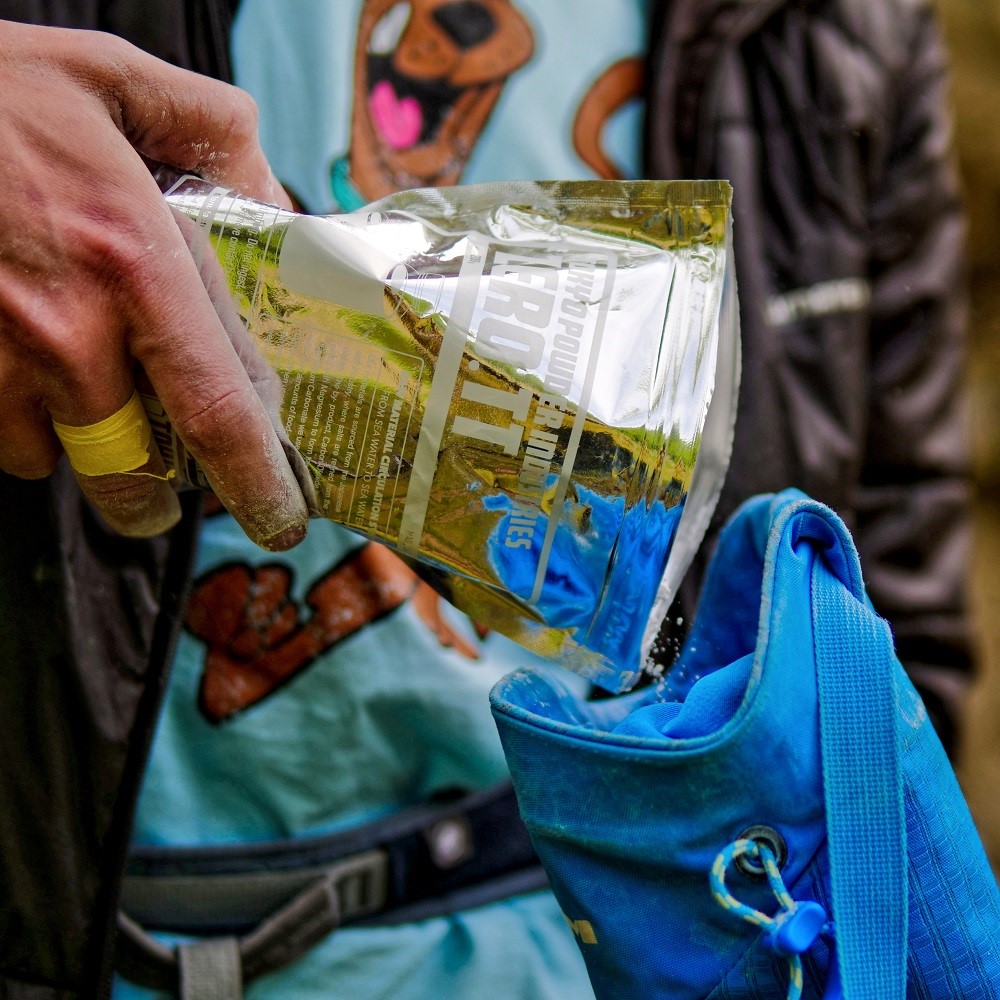
🧗♂️ Climbing but your hands keep slipping?
Maybe it’s time to take a closer look at your chalk.
Climbing chalk – also known as magnesium carbonate or simply chalk – is an essential part of every climber’s gear.
It prevents sweaty hands, increases friction, and gives you a stronger grip.
In this article, you'll learn:
👉 What types of chalk exist
👉 How to choose the right one
👉 Why quality and eco-friendly production matter
❓ What is climbing chalk and how does it work?
Chalk is a fine white powder made from magnesium carbonate (MgCO₃).
It absorbs sweat from your fingers and palms, increasing friction between your hand and the rock or hold.
The result? A stronger grip and reduced risk of slipping.
🔍 The purer and higher the quality of the chalk, the better the grip.
🛠️ How is climbing chalk made?
⛏️ Traditional chalk is often mined through surface mining:
-
Involves heavy machinery
-
Impacts the landscape
-
Uses chemicals
🧪 The result is lower purity, reduced quality, and higher environmental impact.
You end up breathing in and absorbing those chemicals through your skin.
🌊 Eco-friendly chalk from the sea:
-
Byproduct of sea salt production
-
99.9% purity
-
Soft texture, skin-friendly
-
Excellent friction
👉 That’s why all TOKYO POWDER products come from the sea.
🎯 Why is chalk crucial for climbing?
Because in climbing, details matter – and dry hands can make all the difference.
Climbing chalk is your trusted partner – on rock, plastic, boulders, in the gym, or at CrossFit.
Climbing without good chalk is like skiing without wax or riding slick tires in the mud.
It's doable, but unnecessarily difficult – and going head-to-head with the best is nearly impossible.
Flow – that magical climbing state – happens only when you feel secure on the holds.
It’s not just about saving money during repeated tries – it’s about the experience.
🧰 Types of climbing chalk: How to choose the right one?
1️⃣ Powdered Chalk
Offers the best grip and fast application.
Benefits:
-
Even finger coverage
-
High friction
-
Skin-friendly
-
Long-lasting on hands
💡 Example: BLACK by TOKYO POWDER – great performance at a reasonable price.
2️⃣ Chunky Chalk
Traditional chalk is poured into pans and dried into blocks, then cut or crushed.
With seawater chalk, it’s the opposite – it starts as powder.
TOKYO POWDER takes the extra step to craft chunks like RX and V3 from pure powder.
These are top-tier products globally.
Downside: Not ideal to apply mid-route on ropes.
👉 That’s why ZERO TT and SUPER B were developed.
3️⃣ Liquid Chalk
Chalk dissolved in alcohol. The type of alcohol used matters.
❗ Some cheap versions use technical alcohol (like for windshield washer fluid) – harsh on skin.
✅ Better options use pharmaceutical-grade alcohol – evaporates quickly, gentle on skin.
Benefits:
-
Less dust
-
Antibacterial properties
-
Long-lasting even after multiple tries
Best for gyms and bouldering.
💡 Example: CRUX Liquid Chalk – rosin-free.
❌ Rosin damages holds. In many outdoor bouldering areas, liquid chalk with rosin is banned – and this trend is spreading into climbing gyms.
4️⃣ Chalk Balls
Chalk inside a fabric ball, released by squeezing.
Pros: Less dust – suitable for gyms
Cons: Weaker friction, less control – not ideal for hard climbing or bouldering
🔎 How to choose the right TOKYO POWDER chalk?
📝 How to use climbing chalk properly?
-
Roped climbing – use a chalk bag on your waist
-
Bouldering – go for a large standing chalk bucket
Apply only as much as you need.
❗ Too much chalk reduces friction – you end up slipping on a chalk layer.
🧹 Brush your holds!
We strongly recommend frequent brushing – it's a service to you and the whole community.
Even the best chalk won’t work if holds are dirty or damp.
They may have absorbed moisture overnight – and there goes your OS/Flash attempt.
🎁 For every order over €80, you’ll get a Pamomini brush – unbeatable value.
📦 How to care for your chalk:
-
Only pour what you’ll use
-
After climbing, seal your chalk bag in an airtight container
-
Don’t leave chalk bags in damp places (car, basement, next to sweaty shoes)
-
Chalk can degrade – it either absorbs moisture or dries out
-
Always squeeze excess air out of original packaging
✋ How to protect your skin while using chalk?
Chalk dries your skin. Don’t forget:
-
TACO file for calluses
✅ Final Thought: Choose quality that performs
Climbing chalk is more than just powder.
It’s your partner on every send – whether you’re going for the top, a flash, or just the joy of movement.
💬 It could be the deciding factor in sending your project today.
Pick the type that suits you best.
💡 Invest in quality – and it will pay off in performance and the climbing experience.
– Riči
